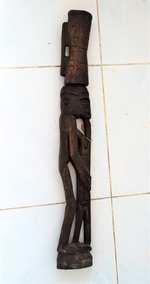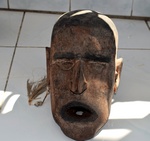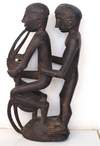Asmat Carvings for Sale
About the Asmat
For nine years, our family lived in what was then called Irian Jaya and is now called Papua. That was back in the days from 1989 through 1998. As soon as I arrived in the mining community of Tembagapura, I became fascinated with the local cultures. The cultures of the highlands are quite different from those of the lowland. So, as I spent each weekend wandering through the local villages outside of the mining camp, I began to collect artifacts: bows and arrows, spears, war vests, nokins (net bags), boars' tusks, and a variety of armbands and necklaces.
During this same time, I came across my first Asmat carving while I was browsing through a small local store set in a small house that an Indonesian family lived in. I'd go there to buy music cassettes and clothes - things that were not available in the camp at the time. It was during one of my first visits that I came across the statue of the nursing mother. There was something about it that just mesmerized me.
In the past, Asmat statues were made of soft wood and colored with the three basic colors: white, red and black.
These days Asmat carvings tend to be made from a hardwood known as ironwood. This change has been attributed to the influence of the Catholic mission which set up the first sawmill in the region. These hardwood figures have the advantage of being able to be highly polished, which seems to be attractive to many collectors. The downside is that many of the figures do not have the coloring found on many of the softwood carvings. This is because the grain of the wood is not rough enough to easily accept paint.
In addition to my Asmat carvings, I will be selling my Kamoro pieces as well. The Kamoro are a group who are the Asmat's neighbors. While not as well known as the Asmat, the Kamoro have been getting better known over the past decade. Their carvings are distinctly different from those of the Asmat as will become apparent as I add more to this site.
I will be adding more carvings, as well as some other artifacts from the Asmat, Kamoro and a few other groups from Papua over the next few weeks. Stay tuned for more beautiful and fascinating "primitive" art.
 Nursing Mother #1A beautiful carving of a mother and child Read more... |
 Crocodile Ashtray #2An amusing little crocodile ashtray make out of ironwood Read more... |
 Ancestor Figure #3This interesting ancestor statue has a drum on top of the ancestor Read more... |
 Wood Skull #4A hardwood skull that is pretty lifelike. Read more... |
 3 Ancestors + Hornbills #5This is a beautiful hardwood carving of three ancestors holding hornbills? Read more... |
 Big Man #6This is one of my larger figures and a favorite Read more... |
.jpg) Kamoro Carving #7This is the first of my Kamoro carvings that I am adding in here. Read more... |
 Sago Bowl #8This is a beautiful softwood sago bowl with very interesting designs on the bottom along with an ancestor figure on the top. Read more... |
.jpg) Nabire Man #9This is a beautiful small carving from the Nabire region in Papua Read more... |
 Male/Female Figures #10An interesting male/female figure where the female is taller than the male. Read more... |
 3 Figures #11Two men are standing on top of a third; the top two are holding a Read more... |
 Ancestor Figures #12This is a unique little piece Read more... |
.jpg) Pregnant Woman #13A hardwood skull that is pretty lifelike. Read more... |
 Small Drum #14Two figures are holding a drum Read more... |
Neckrest #15A beautifully carved neckrest Read more... |
 3 Ancestors #16An ancestor carving with a common motif of men standing on top of each other Read more... |
 Male+Female with Tools #17A male and a female are facing each other holding tools. Read more... |
 Ancestor Figure #18An ancestor figure sitting on an interesting design. Read more... |

